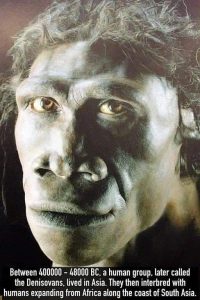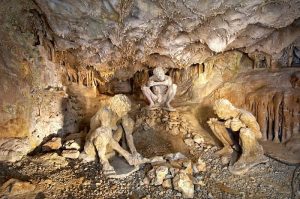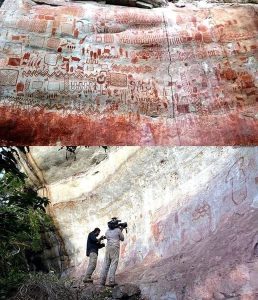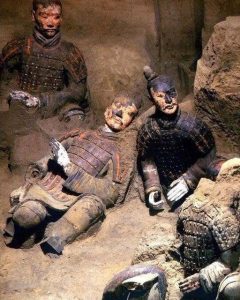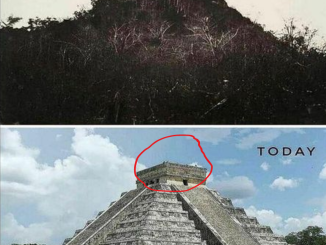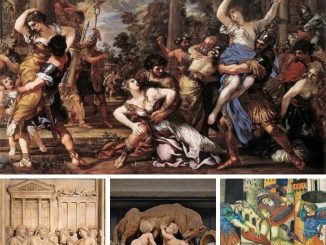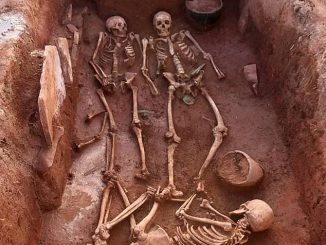The Araña Caves of Valencia: Entering a Bygone Era Through Rock Art
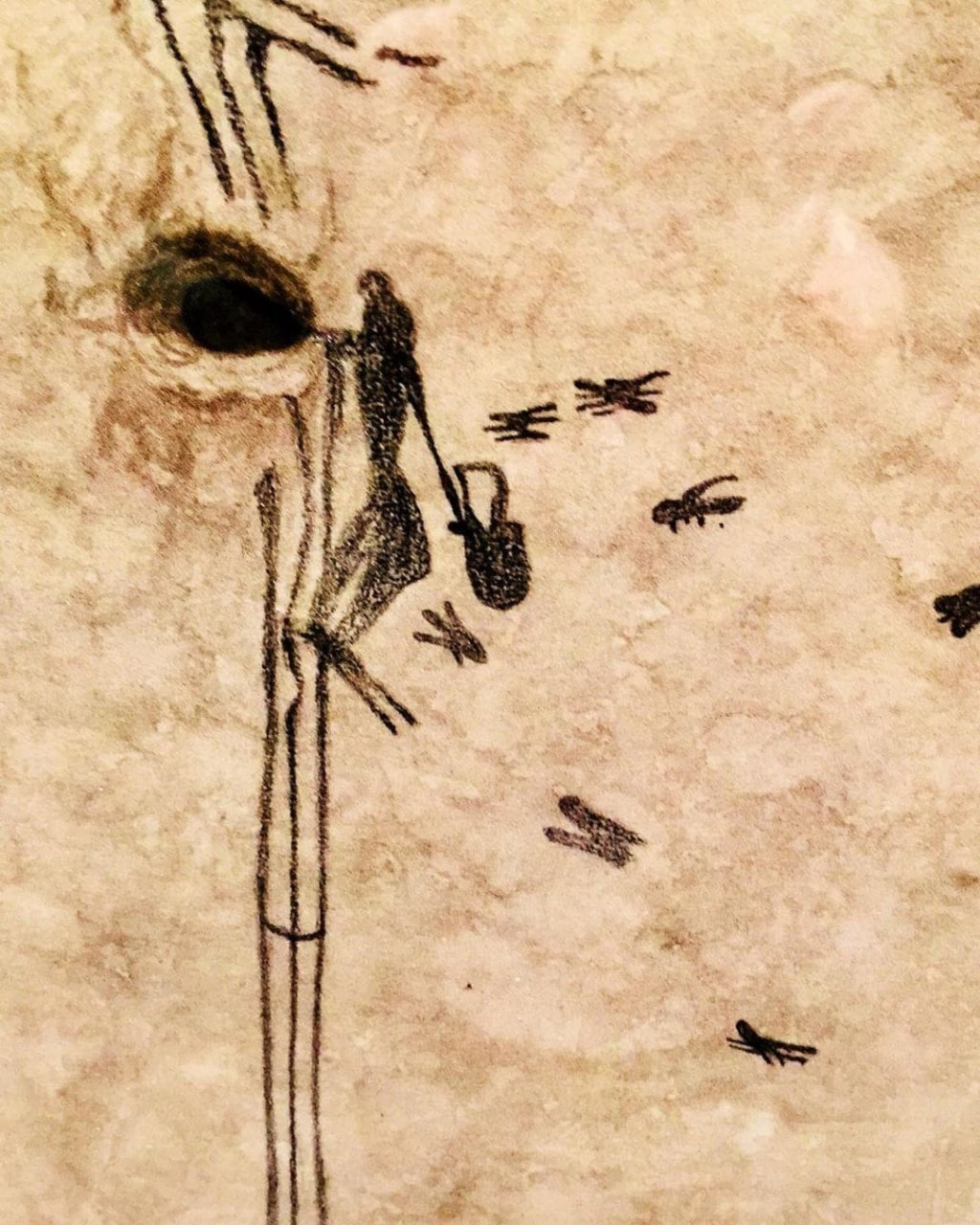
In 1920, a teacher named Jaime Poch heard of some cave paintings near Bicorp in the Caroig mountain range in Valencia, Spain. Now, over a hundred years later, the site known as the Araña Caves is a UNESCO World Heritage Site. Best known for being home to the first depiction of honey-gathering from 8,000 years ago, the Araña Caves are a must-visit destination for travelers with a deep love of archaeology and speleology, and looking to explore the rock art of the Iberian Peninsula.

The first study of the rock paintings at the Araña Caves was conducted by Eduardo Hernández and published in 1924. (Public domain)

Francisco Benítez and Jaime Poch tracing a cave painting in Cuevas de la Araña in 1920. (MNCN)
Discovery of Rock Paintings at the Araña Caves
“At the beginning of 1920… Mr. Jaime Poch y Garí, informed me that during an excursion he had made to the Caroche massif, in In the municipality of Bicorp, in the mountainous area of Valencia, he had heard that in a ravine near the Rebolla waterfall there were deer, goats and men painted on the walls of some caves that exist there; He told me that he had visited the place in question and he encouraged me to study these paintings, which he assumed were from prehistoric times.”(Eduardo Hernández)
Cuevas de la Araña, known in English as the Spider Caves or Araña Caves, is a group of caves near the municipality of Bicorp. While the name conjures images of any arachnophobe’s nightmare, in truth locals are uncertain as to where the name came from, though they believe that it was named after a family who lived close by. The caves themselves are located in a river valley. Forgotten for thousands of years, they were “discovered” in 1920 by Jaime Poch. Four years later, professor Eduardo Hernández published a groundbreaking work entitled Las Pinturas de las Cuevas de la Araña (translating as The Paintings of the Spider Caves), which proposed a post-Palaeolithic chronology for Levantine rock art.
In 2021 alicanteplaza highlighted just four post-Paleolithic sites in Valencia, out of more than 650. The Araña Caves ( Cova de l’Aranya) was one of them. The Spider Caves are famous due to the presence of exceptional examples of prehistoric rock art. The most famous is that of a human figure gathering honey. This image is the first documented evidence of honey collecting in prehistory and it has become a global symbol for apiculture.

Left: Tracing of the honey hunting scene by Eduardo Hernández. Right: Rock painting of honey Hunting at the Araña Caves in Valencia, Spain. (Turismo Comunidad Valenciana)
Honey Hunting at the Araña Caves
The Man, or Woman, of Bicorp, is a figure found in the largest of the caves (cave 2). Presumed to be Epipalaeolithic, it depicts a person holding a rope, ladder or lianas, while gathering honey from a wild beehive with a basket on their back. It is a strikingly beautiful representation of honey hunting, showing the figure introducing their arm inside the hive, with bees flying around them.
Experts believe that this shows that wild honey collection must have occurred in the area around the caves around 8,000 years ago. Honey harvesting was a rich source of nutrients in prehistoric times. This is probably why, along with hunting and other ceremonial activities, it was memorialized on the walls of the Spanish cave.
There have even been recent reenactments of this honey collection, replicating the scene from the Araña Caves rock paintings and reconstructing the rope ladder. While there is evidence of honey hunting throughout the world, the rock paintings at the Araña Caves are the oldest and believed to date back 8,000 years. Beekeeping, meanwhile, was introduced much later, probably around 3,000 BC.

The rock paintings at Cuevas de la Araña near Bicorp are pretty faint and difficult to see with the naked eye. (Superchilum / CC BY-SA 4.0)

Once they’ve been transcribed by experts, their gorgeous depictions of everyday scenes come to life, such as this goat hunting scene above. (Youtube / Ecomuseo de Bicorp)
Faithful Representations of Prehistoric Life
The other cave paintings found at the Araña Caves are also very realistic in style. Of over a hundred which have been identified, one of particular note is a dynamic composition which shows the hunting of a wild goat. In this there are wounded animals and figures with bows and arrows. Like similar rock paintings from the area, these represent hunter-gatherer societies and, besides the bees, focus on the larger mammals. There is also a striking 110 cm image of a bull in cave 3, which appears to have been filled in with color that has now mostly disappeared due to the passage of time.
The authorities have unfortunately surrounded the caves with rather unattractive metal bars which break somewhat with the surrounding scenery. While a necessary evil, there are plans to find a more aesthetic solution. The hike to get there is incredibly beautiful. In 2020, the University of Alicante announced that they would begin a study into the Araña Cave paintings, using infrared photography, in order to learn yet more about these stunning artworks.

These days, the Araña Caves are protected by rather unattractive metal bars. (Naturaleza y Medio Rural)
Cave Paintings in the Iberian Mediterranean Basin
The cave paintings throughout the Caroig Mountains reflect the primary preoccupations of people during the prehistoric era. Once covered by forest, the area was home to species such as horses, goats and deer, all of which became the principal protagonists of the paintings we can see today. There are also depictions of the human form in action. The ancient artists who created them used natural pigments, and amateurs and experts are truly surprised by the high quality craftsmanship displayed.
The rock art from this area has been grouped with over 700 sites from a plethora of locations ranging from the Pyrenees in the north to Granada in the south. As the largest concentration of rock paintings in Europe, this vast group was termed “Rock art of the Iberian Mediterranean Basin” (also known as Levantine art) and was collectively recognized by UNESCO as a World Heritage Site in 1998.

The hiking trails in and around Bicorp and the Caroig mountains are stunning, such as this one which follows the Fraile River. (Superchilum / CC BY-SA 3.0)
Visiting Bicorp: The Araña Caves and Other Attractions
The tours of the Araña caves set out from the Ecomuseo de Bicorp, a small interpretation center in Bicorp. The museum houses a collection of fossils and there are films projections available to learn more about the various discoveries in the area. There is also an ethnographic museum which includes everyday items from the history of the municipality, most of which have been donated by local residents.
The Araña Caves are not the only attraction if you’re visiting Bicorp. There’s also a great hike that passes through Barranco Moreno, a gorgeous gorge known for impressive rock formations, emerald green rock pools and prehistoric cave art. It’s a 18km (11.2 miles) circular route which takes about 4 and a half hours and includes visiting the rock paintings of the Abrigos de Calicanto y Gineses, a hike to hopefully spot mountain goats and golden eagles, and a visit to a restored casa cueva, or cave house, once inhabited by local farmers.
Bicorp is also promoting other Valencian rock art sites within the Caroche massif, part of their “plan to enhance appreciation of Valencian rock art.” These include the Neolithic rock art at Cinto de las Letras and the Levantine art at Abric de Vicent in the Tambuc ravine. The latter features two striking hunting scenes, one of which depicts a solitary hunter following the trail of blood left by an injured and dying goat.
Nearby you can also visit the 400 fossilized dinosaur footprints at Icnitas del Tambuc in Millares which date back 80 million years. Every Saturday morning there are tours available in order to explore these ancient sites. There are also great hikes including the Ruta Fluvial Rio Fraile. Following the River Fraile, this hike gives visitors the chance to literally immerse themselves in nature in one or several of the rock pools along the way.

The Araña Caves in Valencia are a great location to explore with the entire family. (Ecomuseo de Bicorp)
Visiting the Araña Caves
Guided tours to Cuevas de la Araña need to be booked and confirmed at least a day in advance via Ecomuseo Bicorp. They are available from Wednesday to Sunday from 10.30, take about 3 hours, and cost $5 per person. The tour includes entry to the museum, a hike through the incredible landscape, the chance to enjoy the view from the lookout at the Mirador del Chorrador de la Rebolla, and finally a visit to the caves themselves which are located about 10 km (6.2 mi) from Bicorp.


